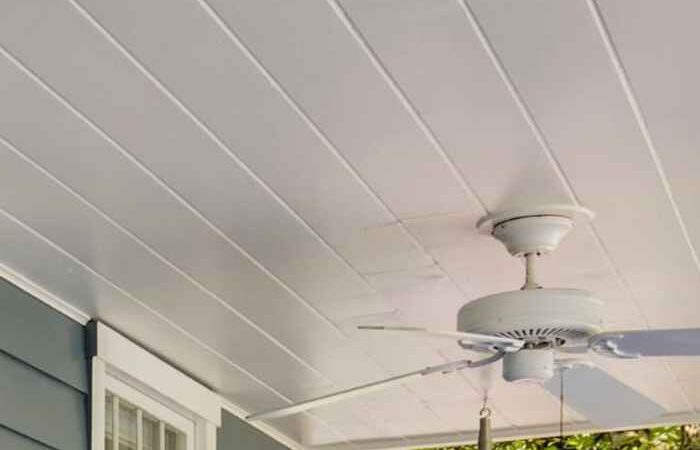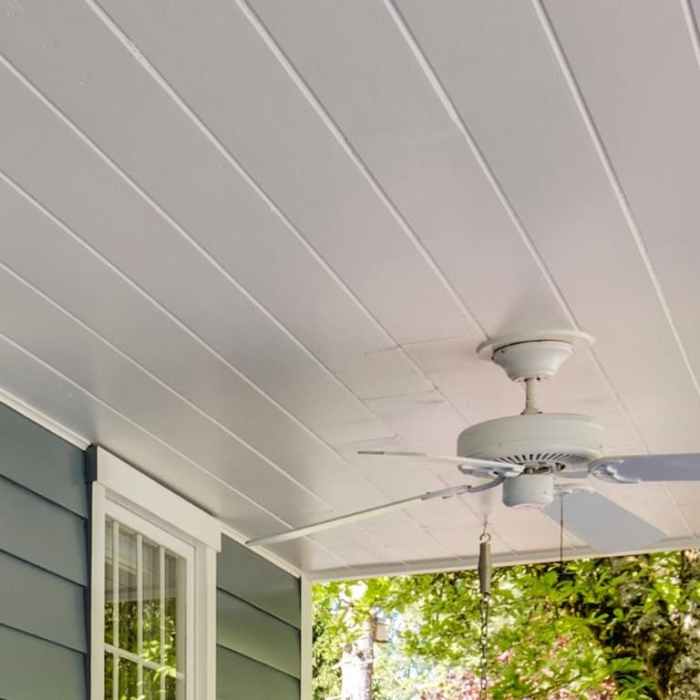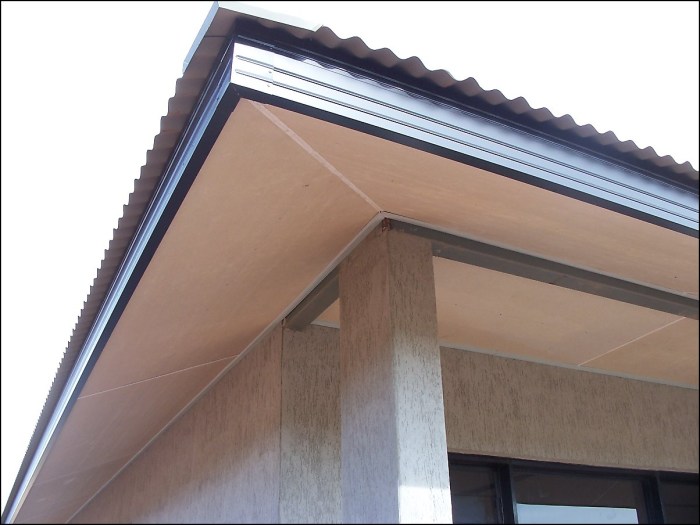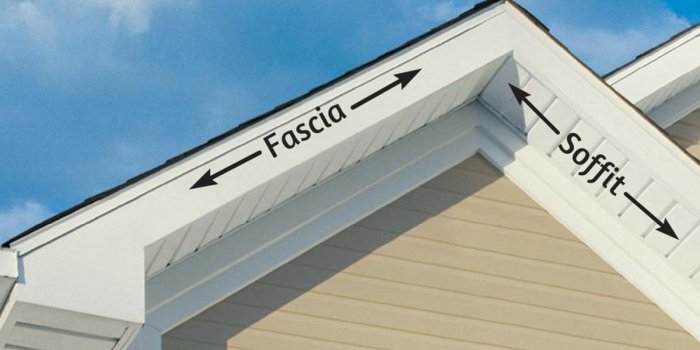Painting Soffits A DIY Guide

Painting soffits is more than just a coat of paint; it’s a chance to dramatically upgrade your home’s curb appeal. This guide walks you through everything from choosing the right paint to mastering the techniques for a professional-looking finish. We’ll cover prepping your soffits, selecting the perfect colors, and ensuring a long-lasting, beautiful result. Get ready to transform your home’s exterior!
We’ll explore the different types of soffits, their materials, and how to best prepare them for painting. Learn about various painting techniques – from brushes and rollers to sprayers – and discover the secrets to choosing the right paint for optimal durability and color retention. We’ll even delve into color theory and offer practical advice on selecting the perfect shade to complement your home’s style.
Understanding Soffits and Their Purpose
Soffits are the underside of an overhanging element, most commonly found under the eaves of a roof or the overhang of a deck. They’re more than just a decorative feature; they play a crucial role in the overall structure and performance of a building. Understanding their function and the materials used in their construction is key to maintaining a healthy and aesthetically pleasing home.
Soffits provide crucial ventilation for your attic or roof space. This ventilation helps prevent moisture buildup, which can lead to mold, mildew, and structural damage. They also help to keep your home cooler in the summer and warmer in the winter by regulating the temperature of the attic. In addition to their functional role, soffits contribute significantly to the overall curb appeal of a house.
Soffit Materials and Their Properties
A variety of materials are used for soffit construction, each with its advantages and disadvantages in terms of cost, durability, and aesthetic appeal. The choice of material often depends on the budget, the architectural style of the house, and the local climate.
- Aluminum: Aluminum soffits are lightweight, durable, and resistant to rust and rot. They come in a wide range of colors and finishes, making them a versatile option. Aluminum’s lifespan can easily exceed 20 years, even in harsh weather conditions, with minimal maintenance required. However, they can dent more easily than some other materials.
- Vinyl: Vinyl soffits are another popular choice due to their affordability and low maintenance. They are also resistant to rot, insects, and moisture. While they are generally durable, they can become brittle and crack under extreme temperature fluctuations. A reasonable lifespan for vinyl soffits is 15-20 years, depending on the quality and environmental factors.
- Wood: Wood soffits offer a classic and aesthetically pleasing look. However, they require more maintenance than aluminum or vinyl, as they are susceptible to rot, and insect damage, and require regular painting or staining. The lifespan of wood soffits depends heavily on the type of wood used and the quality of the finish; with proper maintenance, they can last for many decades, but untreated wood might only last 10-15 years.
- Fiber Cement: Fiber cement soffits are a relatively newer option that combines the strength of cement with the workability of wood fibers. They are very durable, resistant to fire, rot, and insects, and offer a longer lifespan than many other materials. However, they are more expensive than aluminum or vinyl and can be more challenging to install.
Soffit Lifespan and Environmental Factors
The lifespan of soffit materials is significantly impacted by environmental conditions. Coastal areas with high humidity and salt spray will cause faster degradation of most materials, particularly wood. Areas with extreme temperature fluctuations can cause cracking and brittleness in vinyl and some types of wood. Direct sunlight exposure can also fade the color of some materials over time. For example, a vinyl soffit in a sunny desert climate might show significant fading and brittleness within 10 years, while the same soffit in a milder climate might last closer to its expected 20 years. Proper installation and regular maintenance can significantly extend the lifespan of any soffit material.
Aesthetic Considerations for Soffit Materials
The aesthetic appeal of soffits significantly contributes to the overall look of a home. Aluminum soffits offer a clean, modern look and are available in a wide range of colors to complement any architectural style. Vinyl soffits can mimic the appearance of wood, offering a more traditional look at a lower cost. Wood soffits offer a classic, warm, and natural aesthetic, but require more maintenance to retain their appearance. Fiber cement soffits provide a durable and long-lasting finish that can be painted to match any desired color scheme. The choice ultimately depends on personal preference and the overall design of the house.
Painting Soffits
Painting your soffits can dramatically improve your home’s curb appeal and protect them from the elements. This process involves careful preparation and the right techniques to ensure a long-lasting, professional-looking finish. Let’s dive into the specifics of prepping and painting your soffits.
Soffit Preparation, Painting soffits
Proper preparation is key to a successful paint job. Neglecting this step can lead to peeling paint and an uneven finish. The process generally involves cleaning, repairing any damage, and ensuring the surface is completely dry before applying any paint.
- Cleaning: Begin by thoroughly cleaning the soffits to remove dirt, cobwebs, mildew, and any loose paint. A pressure washer is ideal for this, but a stiff brush and a solution of mild detergent and water will also work. Remember to rinse thoroughly and allow the soffits to dry completely. For stubborn mildew, a bleach solution (diluted according to the manufacturer’s instructions) can be effective, but always wear appropriate safety gear, including gloves and eye protection.
- Surface Repair: Inspect the soffits for any cracks, holes, or damaged areas. Use a putty knife to scrape away any loose paint or debris. For small holes and cracks, use a high-quality wood filler. Allow the filler to dry completely before sanding it smooth. For larger repairs, you may need to replace damaged sections of soffit material.
- Priming (Optional but Recommended): Priming the soffits before painting is highly recommended, especially if you’re dealing with bare wood or significant surface imperfections. Primer helps to seal the surface, improve paint adhesion, and provide a more even color. Choose a primer specifically designed for exterior use and suitable for the type of soffit material (wood, vinyl, aluminum, etc.).
Painting Techniques
Several techniques can be used to paint soffits, each with its advantages and disadvantages. The best method will depend on the size of the area, the type of soffit material, and your personal preference.
- Brushing: This method offers excellent control and allows you to reach intricate areas, making it suitable for detailed work and smaller soffits. Use a high-quality brush designed for exterior use and apply thin, even coats to avoid drips and runs.
- Rolling: Rolling is faster and more efficient for larger soffit areas. Use a roller with a nap length appropriate for the surface texture. Overlap each stroke to ensure even coverage. A small brush may still be necessary to reach corners and edges.
- Spraying: Spray painting offers the fastest application, especially for large areas. However, it requires more preparation to protect surrounding areas from overspray and may require specialized equipment. Ensure proper ventilation and wear a respirator to avoid inhaling paint fumes.
Paint and Primer Selection
Choosing the right paint and primer is crucial for a durable and long-lasting finish. Exterior paints are formulated to withstand the elements, including sun, rain, and temperature fluctuations. Look for paints that are mildew-resistant and offer good UV protection. Consider the color carefully; lighter colors tend to reflect heat and keep the soffits cooler. Always follow the manufacturer’s instructions regarding application and drying time. For example, high-quality acrylic latex paint is often a good choice for its durability and ease of application.
Sample Project Plan
This plan Artikels a typical project for painting soffits on a single-story house with approximately 200 square feet of soffit area. Adjust the timeline and materials based on your specific project.
| Task | Materials | Timeline |
|---|---|---|
| Cleaning and Preparation | Pressure washer, detergent, brushes, scraper, wood filler, sandpaper | 1-2 hours |
| Priming (if needed) | Exterior primer | 2-4 hours (including drying time) |
| Painting | Exterior paint, rollers, brushes, paint trays | 4-6 hours (including drying time between coats) |
| Cleanup | Cleaning supplies | 1 hour |
Always remember to check the weather forecast before starting your project and work on a day with favorable conditions. Allow adequate drying time between coats of primer and paint. Safety first! Wear appropriate protective gear throughout the process.
Paint Selection for Soffits: Painting Soffits
Choosing the right paint for your soffits is crucial for long-lasting protection and a beautiful finish. Soffits, being exposed to the elements, require a durable and weather-resistant paint that can withstand sun, rain, and temperature fluctuations. The wrong paint choice can lead to peeling, fading, and costly repainting shortly.
Choosing the right paint involves considering several factors, including the type of paint, its durability, color retention, and ease of maintenance. Let’s explore the characteristics of different exterior paints suitable for soffits.
Exterior Paint Types for Soffits
Acrylic, latex, and oil-based paints are common choices for exterior painting projects, each with its advantages and disadvantages. Acrylic paints are water-based, making them easy to clean up and low in volatile organic compounds (VOCs). They offer good durability and color retention, but might not be as durable as oil-based paints in extreme climates. Latex paints, also water-based, provide excellent adhesion and flexibility, making them suitable for various surfaces. They are relatively easy to apply and clean up. Oil-based paints offer superior durability and water resistance, making them ideal for harsh weather conditions. However, they take longer to dry, require solvents for cleanup, and have higher VOCs.
Comparison of Exterior Paints for Soffits
The table below compares four common exterior paints suitable for soffits, highlighting their key features and price ranges. Price ranges are estimates and can vary depending on brand, retailer, and quantity purchased.
| Paint Type | Durability | Color Retention | Maintenance | Price Range (per gallon) |
|---|---|---|---|---|
| Acrylic Latex | Good to Excellent (depending on quality) | Good | Low to Moderate | $25 – $50 |
| 100% Acrylic | Excellent | Excellent | Low | $35 – $70 |
| Alkyd (Oil-Based) | Excellent | Good to Excellent | Moderate | $40 – $80 |
| Acrylic-Alkyd Hybrid | Excellent | Excellent | Low to Moderate | $45 – $90 |
Color Considerations for Soffit Painting
Choosing the right color for your soffits can significantly impact your home’s curb appeal and overall aesthetic. The color you select interacts with the house’s siding, roof, and landscaping, creating a harmonious or jarring effect. Careful consideration of color can enhance architectural details and even subtly alter the perceived size and proportions of your home.
Soffit color influences the overall appearance of a building by creating visual balance and depth. A lighter soffit color can make a house appear larger and brighter, especially if the house is situated in a shady area. Conversely, darker colors can add drama and a sense of groundedness, working particularly well with more substantial architectural styles. The contrast between the soffit and the siding or fascia can highlight architectural details, creating visual interest and adding character to the home’s exterior.
Soffit Color and Architectural Style
The architectural style of your home should heavily influence your soffit color choice. For example, a traditional Victorian home might benefit from a rich, deep color that complements the intricate details of the home’s facade, perhaps a deep burgundy or a sophisticated dark green. A contemporary, minimalist home, on the other hand, might look best with a neutral color like a light gray or crisp white that accentuates the clean lines and modern design. A craftsman-style home could use earthy tones, like a warm brown or a muted green, to blend seamlessly with natural surroundings. Consider the overall color palette of the house and strive for a cohesive look.
Color Palettes for Different Architectural Styles and Building Materials
Here are some examples of color palettes that work well with various architectural styles and building materials:
- Victorian: Deep greens, burgundy, and dark browns, paired with cream or off-white siding. The darker soffit color complements the ornate detailing, adding depth and richness to the facade.
- Contemporary: Light grays, crisp whites, muted blues, or even black. These colors create a clean, modern look and allow the architecture to speak for itself.
- Craftsman: Earthy tones like browns, greens, and muted yellows, complement natural wood siding or stone accents. These colors create a sense of warmth and connection to nature.
- Ranch: Muted earth tones such as beige, taupe, or light browns. These colors often complement stucco or brick siding and blend seamlessly with the surrounding landscape.
Color Schemes Considering Light Exposure and Environment
The amount of sunlight your home receives and the surrounding environment significantly impact your soffit color choices. Homes in sunny climates may benefit from lighter colors to reflect heat and prevent the soffits from becoming excessively hot. Conversely, homes in shady areas might benefit from darker colors to add warmth and visual interest. Consider the colors of your landscaping and neighboring homes to ensure a cohesive and visually appealing exterior. For example, a home surrounded by lush greenery might look stunning with a deep green or earthy brown soffit, while a home near a beach might be better suited to a light blue or white.
Safety Precautions During Soffit Painting

Source: co.nz
Painting soffits often involves working at heights, handling potentially hazardous materials, and navigating confined spaces. Prioritizing safety is crucial to prevent accidents and injuries. This section details essential safety measures to ensure a safe and successful painting project.
Working at Heights and Ladder Safety
Safe ladder use is paramount when painting soffits. Always choose a ladder that extends at least three feet above the highest point you need to reach. Ensure the ladder is placed on a stable, level surface, and never overextend yourself to reach areas beyond the ladder’s safe reach. For extra stability, consider using ladder stabilizers or having a helper hold the base. If working at significant heights, a safety harness secured to a stable anchor point is highly recommended. This harness will prevent falls should you lose your balance. Remember to always inspect your ladder before each use, checking for any damage or loose parts. Never climb a ladder in windy conditions.
Personal Protective Equipment (PPE)
Appropriate personal protective equipment is essential to protect yourself from paint splashes, dust, and other potential hazards. This includes safety glasses or goggles to shield your eyes from paint splatters and debris. A dust mask or respirator is necessary to prevent inhalation of paint fumes and dust particles, particularly when working with older, lead-based paints. Wear long-sleeved clothing and long pants to protect your skin from paint and sun exposure. Durable work gloves will protect your hands from abrasions and chemicals. Finally, sturdy work boots provide good footing and ankle support, minimizing the risk of slips and falls.
Safe Handling and Disposal of Paint and Materials
Proper handling and disposal of paint and related materials are crucial for environmental protection and personal safety. Always store paint in a well-ventilated area, away from heat sources and ignition sources. Follow the manufacturer’s instructions for mixing and applying the paint. Use drop cloths to minimize paint spills and drips. When cleaning brushes and rollers, do so in designated areas with appropriate solvents and dispose of waste properly. Never pour paint down drains or into the environment. Instead, check with your local waste disposal authority for proper disposal methods for leftover paint and related materials. Many communities offer hazardous waste collection days or designated drop-off locations.
Potential Hazards and Mitigation Strategies
Several hazards are associated with soffit painting. Falls from ladders or heights are a major concern, mitigated by using appropriate ladders, and safety harnesses, and maintaining three points of contact on the ladder at all times. Exposure to paint fumes and dust can cause respiratory problems; wearing a respirator and ensuring adequate ventilation minimizes this risk. Skin irritation from paint can be avoided by wearing long sleeves, long pants, and gloves. Electrical hazards exist if working near power lines; always maintain a safe distance and never touch exposed wires. Slips and falls can occur on uneven surfaces; use appropriate footwear and ensure the work area is clean and dry. Finally, exposure to lead-based paint in older homes poses a significant health risk; proper testing and professional remediation should be undertaken if lead paint is suspected.
Troubleshooting Common Soffit Painting Issues

Source: your news .in
Painting soffits can seem straightforward, but several issues can crop up, leading to less-than-perfect results or even premature paint failure. Understanding these common problems and how to address them is key to achieving a long-lasting, beautiful finish. This section will cover some of the most frequent challenges and provide practical solutions for both fixing existing problems and preventing future ones.
Peeling Paint
Peeling paint is a common problem, often stemming from poor surface preparation before painting. Existing paint that’s not properly adhered to the soffit material will inevitably peel. This can be caused by moisture intrusion, old, flaking paint, or even using the wrong type of paint for the substrate. To address peeling paint, you must first remove all loose and flaking paint. This can be done using a scraper, wire brush, or even a pressure washer (use caution!). Once the surface is clean and sound, you’ll need to apply a quality primer designed for adhesion, followed by your chosen paint. Preventing future peeling involves ensuring the soffit is clean and dry before painting, using appropriate primers, and selecting a paint suitable for exterior use and the material of the soffit (wood, vinyl, aluminum, etc.).
Mildew Growth
Mildew thrives in damp, shady areas, making soffits a potential breeding ground. The appearance of mildew is unsightly and can damage the paint, necessitating repainting. Before repainting, thoroughly clean the soffit with a solution of bleach and water (always follow manufacturer instructions for safe dilution and application). Allow the area to dry completely before applying a mildew-resistant primer and paint. To prevent future mildew growth, ensure adequate ventilation in the soffit area, preventing moisture buildup. Regular cleaning and the use of mildew-resistant paint can also significantly reduce the risk.
Uneven Finishes
Uneven finishes are often the result of improper application techniques. This could include using too much paint, not allowing sufficient drying time between coats, or using a roller with an inappropriate nap length. Addressing unevenness might involve light sanding to smooth out imperfections, followed by a touch-up coat of paint. Prevention focuses on using the right tools and techniques: apply thin, even coats, allow ample drying time, and use appropriate rollers and brushes for the surface texture. A high-quality paint will also contribute to a smoother, more even finish.
Repairing Damaged Soffit Surfaces
Before repainting, address any damaged areas. This might involve filling cracks or holes with a suitable filler, such as wood filler for wooden soffits or caulk for gaps in vinyl or aluminum soffits. Allow the filler to dry completely and sand smooth before priming and painting. Ignoring damage before painting will lead to an uneven finish and potential future problems. For significant damage, replacement sections might be necessary.
Preventative Maintenance
Regular cleaning and inspection are crucial for extending the life of your painted soffits. At least once a year, inspect for signs of damage, mildew, or peeling paint. Clean the soffits with a gentle cleaner and water to remove dirt and debris. Addressing minor issues promptly will prevent them from becoming major problems, saving you time and money in the long run. Regular maintenance will help your painted soffits stay looking their best for years to come.
Illustrative Examples of Painted Soffits
Let’s look at some real-world examples of painted soffits to illustrate how different choices in materials, colors, and architectural styles can dramatically impact the overall look of a home. These examples demonstrate the versatility of soffit painting and how it can enhance curb appeal.
Victorian Home with Wood Soffits and a Deep Teal Paint
Imagine a charming Victorian home with intricately carved wooden soffits. Painting these soffits a deep teal creates a striking contrast against the lighter-colored siding. The rich, dark teal enhances the architectural details of the wood, making them pop. The slightly textured surface of the wood, even after a smooth coat of paint, retains a subtle depth, adding visual interest. The overall aesthetic effect is one of sophisticated elegance and timeless charm. The deep teal provides a dramatic focal point, drawing the eye upwards and highlighting the home’s architectural character. The color choice is bold yet classic, suitable for a period home seeking to emphasize its history and beauty.
Modern Farmhouse with Vinyl Soffits and a Crisp White Paint
Now, picture a modern farmhouse with clean lines and simple detailing. The soffits, made of durable vinyl, are painted a crisp, bright white. This choice perfectly complements the farmhouse aesthetic. The smooth, even surface of the vinyl provides a flawless canvas for the paint, creating a clean and modern look. The bright white reflects light, making the space under the eaves appear brighter and more open. The overall effect is one of airy freshness and understated sophistication. The white soffits contribute to the overall feeling of spaciousness and cleanliness, a hallmark of modern farmhouse design. This clean, bright aesthetic is both timeless and contemporary.
Mediterranean-Style Home with Stucco Soffits and a Warm Terracotta Paint
Consider a Mediterranean-style home with stucco soffits. Painting these soffits a warm terracotta color enhances the home’s rustic charm. The slightly textured surface of the stucco subtly interacts with the paint, creating a slightly uneven but appealing finish. The terracotta color evokes a sense of warmth and earthiness, perfectly complementing the architectural style. The overall aesthetic is one of relaxed elegance and sun-drenched warmth. The terracotta subtly reflects the warm tones often associated with Mediterranean climates, tying the home seamlessly into its surroundings. The color choice is both visually appealing and contextually appropriate, enhancing the home’s overall character.
Final Wrap-Up

Source says media-content.com
Painting your soffits can seem daunting, but with the right preparation and techniques, it’s a manageable DIY project that yields impressive results. Remember, proper surface preparation is key to a long-lasting finish. By carefully selecting your paint and employing safe working practices, you can transform your home’s exterior and enhance its overall aesthetic appeal for years to come. So grab your brushes and let’s get started!
FAQ Guide
Can I paint soffits in cold weather?
It’s best to avoid painting soffits in cold temperatures (below 50°F/10°C) as the paint may not dry properly, leading to peeling or cracking.
How often should I repaint my soffits?
The frequency depends on the paint type and environmental conditions. High-quality exterior paints can last 5-10 years, but regular inspections are recommended to catch issues early.
What if I have mildew on my soffits?
Clean the mildew with a solution of bleach and water before painting. Always wear appropriate protective gear when working with bleach.
How do I deal with peeling paint?
Scrape off all loose paint, prime the bare wood, and then apply a fresh coat of paint. Consider using a paint scraper and wire brush for stubborn areas.
Comments are closed.